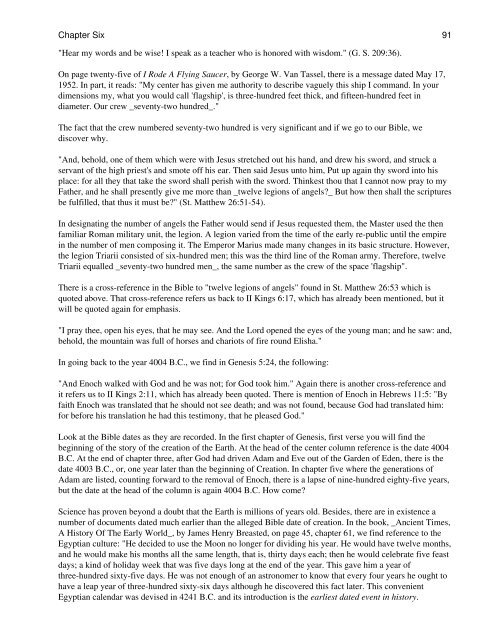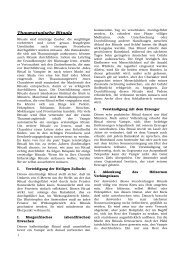CHAPTER 2 CHAPTER 3 CHAPTER 1 CHAPTER 2 CHAPTER 3 ...
CHAPTER 2 CHAPTER 3 CHAPTER 1 CHAPTER 2 CHAPTER 3 ...
CHAPTER 2 CHAPTER 3 CHAPTER 1 CHAPTER 2 CHAPTER 3 ...
You also want an ePaper? Increase the reach of your titles
YUMPU automatically turns print PDFs into web optimized ePapers that Google loves.
Chapter Six 91<br />
"Hear my words and be wise! I speak as a teacher who is honored with wisdom." (G. S. 209:36).<br />
On page twenty-five of I Rode A Flying Saucer, by George W. Van Tassel, there is a message dated May 17,<br />
1952. In part, it reads: "My center has given me authority to describe vaguely this ship I command. In your<br />
dimensions my, what you would call 'flagship', is three-hundred feet thick, and fifteen-hundred feet in<br />
diameter. Our crew _seventy-two hundred_."<br />
The fact that the crew numbered seventy-two hundred is very significant and if we go to our Bible, we<br />
discover why.<br />
"And, behold, one of them which were with Jesus stretched out his hand, and drew his sword, and struck a<br />
servant of the high priest's and smote off his ear. Then said Jesus unto him, Put up again thy sword into his<br />
place: for all they that take the sword shall perish with the sword. Thinkest thou that I cannot now pray to my<br />
Father, and he shall presently give me more than _twelve legions of angels?_ But how then shall the scriptures<br />
be fulfilled, that thus it must be?" (St. Matthew 26:51-54).<br />
In designating the number of angels the Father would send if Jesus requested them, the Master used the then<br />
familiar Roman military unit, the legion. A legion varied from the time of the early re-public until the empire<br />
in the number of men composing it. The Emperor Marius made many changes in its basic structure. However,<br />
the legion Triarii consisted of six-hundred men; this was the third line of the Roman army. Therefore, twelve<br />
Triarii equalled _seventy-two hundred men_, the same number as the crew of the space 'flagship".<br />
There is a cross-reference in the Bible to "twelve legions of angels" found in St. Matthew 26:53 which is<br />
quoted above. That cross-reference refers us back to II Kings 6:17, which has already been mentioned, but it<br />
will be quoted again for emphasis.<br />
"I pray thee, open his eyes, that he may see. And the Lord opened the eyes of the young man; and he saw: and,<br />
behold, the mountain was full of horses and chariots of fire round Elisha."<br />
In going back to the year 4004 B.C., we find in Genesis 5:24, the following:<br />
"And Enoch walked with God and he was not; for God took him." Again there is another cross-reference and<br />
it refers us to II Kings 2:11, which has already been quoted. There is mention of Enoch in Hebrews 11:5: "By<br />
faith Enoch was translated that he should not see death; and was not found, because God had translated him:<br />
for before his translation he had this testimony, that he pleased God."<br />
Look at the Bible dates as they are recorded. In the first chapter of Genesis, first verse you will find the<br />
beginning of the story of the creation of the Earth. At the head of the center column reference is the date 4004<br />
B.C. At the end of chapter three, after God had driven Adam and Eve out of the Garden of Eden, there is the<br />
date 4003 B.C., or, one year later than the beginning of Creation. In chapter five where the generations of<br />
Adam are listed, counting forward to the removal of Enoch, there is a lapse of nine-hundred eighty-five years,<br />
but the date at the head of the column is again 4004 B.C. How come?<br />
Science has proven beyond a doubt that the Earth is millions of years old. Besides, there are in existence a<br />
number of documents dated much earlier than the alleged Bible date of creation. In the book, _Ancient Times,<br />
A History Of The Early World_, by James Henry Breasted, on page 45, chapter 61, we find reference to the<br />
Egyptian culture: "He decided to use the Moon no longer for dividing his year. He would have twelve months,<br />
and he would make his months all the same length, that is, thirty days each; then he would celebrate five feast<br />
days; a kind of holiday week that was five days long at the end of the year. This gave him a year of<br />
three-hundred sixty-five days. He was not enough of an astronomer to know that every four years he ought to<br />
have a leap year of three-hundred sixty-six days although he discovered this fact later. This convenient<br />
Egyptian calendar was devised in 4241 B.C. and its introduction is the earliest dated event in history.






